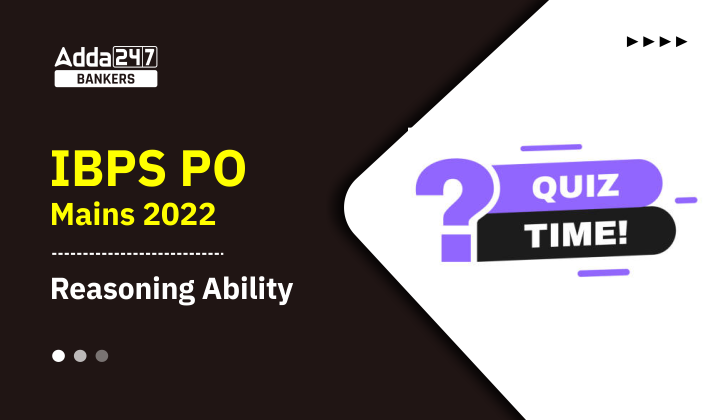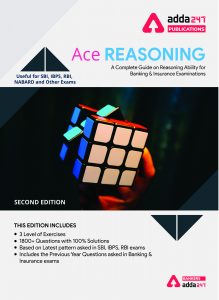Directions (1-5): The question given below consists of two statements numbered and II given below it. You have to decide whether the data provided in the statements are sufficient to answer the question. Read all the statements and give answer.
Q1. Seven persons P, Q, R, S, E, F and G live on 7 floors such that ground floor is numbered as and floor above ground floor is numbered as 2 and so on. Who lives on 6th floor?
Statements:
I. Only two persons live between floors on which P and G live. F lives immediately above the G. E lives on an even number floor.
II. S lives on 4th floor. Only two persons live above P. R lives on an odd numbered floor. G lives on an even numbered floor.
(a) The data in statement I alone are sufficient to answer the question, while the data in statement II alone are not sufficient to answer the question.
(b) The data in statement II alone are sufficient to answer the question, while the data in statement I alone are not sufficient to answer the question.
(c) The data either in statement I alone or in statement II alone are sufficient to answer the question.
(d) The data given in statements I and II together are not sufficient to answer the question.
(e) The data in statements I and II together are necessary to answer the question.
Q2. Seven stones A, B, C, D, E, F and G have different brightness intensities. Which of the given stone is the brightest?
Statements:
I. Only two stones are less brighter than the stone C. Stone D is brighter than stone A, which is brighter than stone G. Stone E is the 2nd brightest stone. Stone F is the least bright stone among all.
II. The number of stones brighter than stone A is same as the number of stones less brighter than stone A. Stone G is less brighter than stone C but brighter than stone F.
(a) The data in statement I alone are sufficient to answer the question, while the data in statement II alone are not sufficient to answer the question.
(b) The data in statement II alone are sufficient to answer the question, while the data in statement I alone are not sufficient to answer the question.
(c) The data either in statement I alone or in statement II alone are sufficient to answer the question.
(d) The data given in statements I and II together are not sufficient to answer the question.
(e) The data in statements I and II together are necessary to answer the question.
Q3. Six teams Kerala, Goa, Sikkim, Delhi, Manipur, and Punjab are participating in a race. Which of the following team wins the race?
Statements:
I. Only two teams finish race before Delhi. One team finishes race between Delhi and Punjab. Only Sikkim finishes race after Goa.
II. Manipur finishes race just after Punjab. Delhi finishes race just before Kerala. Sikkim finishes race just after Goa.
(a) The data in statement I alone are sufficient to answer the question, while the data in statement II alone are not sufficient to answer the question.
(b) The data in statement II alone are sufficient to answer the question, while the data in statement I alone are not sufficient to answer the question.
(c) The data either in statement I alone or in statement II alone are sufficient to answer the question.
(d) The data given in statements I and II together are not sufficient to answer the question.
(e) The data in statements I and II together are necessary to answer the question.
Q4. Six persons Tina, Rina, Mina, Kina, Pina, and Sima belong to a family of two generations. How is Kima related to Pina?
Statements:
I. Tina is husband of Kina. Mine and Pina belong to 2nd generation. Rina is wife of Sima. Pina is brother of Mina.
II. Kina is married to father of Mina. Sima is brother-in-law of Tina. Mina is a male member. Pina is nephew of Sima who is married to Rina.
(a) The data in statement I alone are sufficient to answer the question, while the data in statement II alone are not sufficient to answer the question.
(b) The data in statement II alone are sufficient to answer the question, while the data in statement I alone are not sufficient to answer the question.
(c) The data either in statement I alone or in statement II alone are sufficient to answer the question.
(d) The data given in statements I and II together are not sufficient to answer the question.
(e) The data in statements I and II together are necessary to answer the question.
Q5. Seven persons A, B, C, D, E, F and G are born on seven different days of a week starting from Sunday. Who was born on Saturday?
Statements:
I. B was born just before C. Only two persons are born after G. Three persons are born between G and A. E was born two days after A.
II. D was born on Wednesday. C was born after B. Two persons are born between D and A. A was not born on Saturday. B was born one of the days after Thursday.
(a) The data in statement I alone are sufficient to answer the question, while the data in statement II alone are not sufficient to answer the question.
(b) The data in statement II alone are sufficient to answer the question, while the data in statement I alone are not sufficient to answer the question.
(c) The data either in statement I alone or in statement II alone are sufficient to answer the question.
(d) The data given in statements I and II together are not sufficient to answer the question.
(e) The data in statements I and II together are necessary to answer the question.
Directions (6-10): The question given below consists of two statements numbered and II given below it. You have to decide whether the data provided in the statements are sufficient to answer the question. Read all the statements and give answer.
Q6. Eight persons P, Q, R, S, T, U, V and W live in eight storey building. The bottommost floor is numbered as 1 and the topmost floor is numbered as 8. Who lives on third floor?
Statements:
I. V lives two floors above T who lives in prime number floor. One person lives between S and T.
II. P lives immediately below S. Four persons live between P and V.
(a) The data in statement I alone are sufficient to answer the question, while the data in statement II alone are not sufficient to answer the question.
(b) The data in statement II alone are sufficient to answer the question, while the data in statement I alone are not sufficient to answer the question.
(c) The data either in statement I alone or in statement II alone are sufficient to answer the question.
(d) The data given in statements I and II together are not sufficient to answer the question.
(e) The data in statements I and II together are necessary to answer the question.
Q7. Six persons A, B, C, D, E and F sit in a linear row facing north. Who sits immediate left of B?
Statements:
I. A sits third to the left of F. B sits immediate left of F.
II. Two persons sit between B and C. Neither B nor C sits at the end of the row.
(a) The data in statement I alone are sufficient to answer the question, while the data in statement II alone are not sufficient to answer the question.
(b) The data in statement II alone are sufficient to answer the question, while the data in statement I alone are not sufficient to answer the question.
(c) The data either in statement I alone or in statement II alone are sufficient to answer the question.
(d) The data given in statements I and II together are not sufficient to answer the question.
(e) The data in statements I and II together are necessary to answer the question.
Q8. Seven people, R, S, G, T, N, J and H purchased washing machine from a sale on different days of the same week. Sale started on Monday and ended on Sunday. How many people purchased after N?
Statements:
I. R purchased either on Monday or Thursday. Two people purchased between R and G. Three people purchased between G and H. N purchased three days after T. S purchased after J.
II. S purchased immediately after N. J purchased four days before N. T purchased immediately before R. H purchased after R. G purchased before T. J does not purchase on Monday.
(a) The data in statement I alone are sufficient to answer the question, while the data in statement II alone are not sufficient to answer the question.
(b) The data in statement II alone are sufficient to answer the question, while the data in statement I alone are not sufficient to answer the question.
(c) The data either in statement I alone or in statement II alone are sufficient to answer the question.
(d) The data given in statements I and II together are not sufficient to answer the question.
(e) The data in statements I and II together are necessary to answer the question
Q9. In the given coded language how is the wand ‘Father’ coded?
Statements:
I. In a certain language, “father of the nation is coded as ‘qpr, qrp, pqr, prq’ and ‘child father of man’ is coded as ‘rqp, prq, pqr, rpq’.
II. In a certain language, ‘Make our nation proud’ is colded as rsp, srp, qpr, prs’ and ‘proud father of child’ is coded as ‘pqr, prq, rpq, srp’.
(a) The data in statement I alone are sufficient to answer the question, while the data in statement II alone are not sufficient to answer the question.
(b) The data in statement II alone are sufficient to answer the question, while the data in statement I alone are not sufficient to answer the question.
(c) The data either in statement I alone or in statement II alone are sufficient to answer the question.
(d) The data given in statements I and II together are not sufficient to answer the question.
(e) The data in statements I and II together are necessary to answer the question
Q10. Six persons A, B, C, D, E and F are sitting on a circular table facing towards the centre. Who among the following sits to the immediate right of D?
Statements:
1. B sits to the immediate left of E. D is not apposite to B. C and D are adjacent to each other.
II. F sits opposite to one who sits to the immediate left of D. E sits second to the right of F. A is not adjacent to E.
(a) The data in statement I alone are sufficient to answer the question, while the data in statement II alone are not sufficient to answer the question.
(b) The data in statement II alone are sufficient to answer the question, while the data in statement I alone are not sufficient to answer the question.
(c) The data either in statement I alone or in statement II alone are sufficient to answer the question.
(d) The data given in statements I and II together are not sufficient to answer the question.
(e) The data in statements I and II together are necessary to answer the question
Directions (11-15): The question given below consists of two statements numbered and II given below it. You have to decide whether the data provided in the statements are sufficient to answer the question. Read all the statements and give answer.
Q11. Six persons A, B, C, D, E and F are sitting in a row facing north. Who among the following sits to the immediate left of C?
Statements:
I. Two persons sit between E and F. B is adjacent to E. D sits to the right of C.
II. A and D are not adjacent to each other. One person sits between C and D. B sits at the extreme end. E sits third to the left of F, who is adjacent to C?
(a) The data in statement I alone are sufficient to answer the question, while the data in statement II alone are not sufficient to answer the question.
(b) The data in statement II alone are sufficient to answer the question, while the data in statement I alone are not sufficient to answer the question.
(c) The data either in statement I alone or in statement II alone are sufficient to answer the question.
(d) The data given in statements I and II together are not sufficient to answer the question.
(e) The data in statements I and II together are necessary to answer the question
Q12. Six persons P, Q, R, S, T and U are sitting in a row facing north. Who among the following is sitting at the extreme left end?
Statements:
I. P sits third to the right of R. Q is adjacent to P. T sits to the immediate right of S and neither is adjacent to R.
II. Two persons sit between U and S. T is adjacent to S.
(a) The data in statement I alone are sufficient to answer the question, while the data in statement II alone are not sufficient to answer the question.
(b) The data in statement II alone are sufficient to answer the question, while the data in statement I alone are not sufficient to answer the question.
(c) The data either in statement I alone or in statement II alone are sufficient to answer the question.
(d) The data given in statements I and II together are not sufficient to answer the question.
(e) The data in statements I and II together are necessary to answer the question
Q13. There are eight members in a family, A, B, C, D, E, F, G and H. How is G related to H?
Statements:
I. D is the daughter of G. D is the only sister in law of E who is the wife of B who is the father of F. F is the only brother of H.
II. G is the wife of A, who is the father of D. D is the only sister of B who is the husband of E. E is the mother of H’s only brother.
(a) The data in statement I alone are sufficient to answer the question, while the data in statement II alone are not sufficient to answer the question.
(b) The data in statement II alone are sufficient to answer the question, while the data in statement I alone are not sufficient to answer the question.
(c) The data either in statement I alone or in statement II alone are sufficient to answer the question.
(d) The data given in statements I and II together are not sufficient to answer the question.
(e) The data in statements I and II together are necessary to answer the question.
Q14. Seven persons, A, B, C, D, E, F and G are sitting at some distance from each other. What is the direction of B with respect to D?
Statements:
I. A is sitting 8m west to B. D is sitting 12m south to E who is sitting 9m west to F.
II. B is sitting 15m to the south west of G. C is sitting 5m west to G.
(a) The data in statement I alone are sufficient to answer the question, while the data in statement II alone are not sufficient to answer the question.
(b) The data in statement II alone are sufficient to answer the question, while the data in statement I alone are not sufficient to answer the question.
(c) The data either in statement I alone or in statement II alone are sufficient to answer the question.
(d) The data given in statements I and II together are not sufficient to answer the question.
(e) The data in statements I and II together are necessary to answer the question.
Q15. Six boxes A through F are placed one above another such that the bottommost position is 1 and the position above it is 2 and so on. Which among the following is placed at the topmost position?
Statements:
I. A is placed 2nd to the above of D which is placed just above B. E which is not at the topmost position, is placed 2nd to the above of F.
II. F is placed 2nd to the above of B. Two boxes are placed between E and D.
(a) The data in statement I alone are sufficient to answer the question, while the data in statement II alone are not sufficient to answer the question.
(b) The data in statement II alone are sufficient to answer the question, while the data in statement I alone are not sufficient to answer the question.
(c) The data either in statement I alone or in statement II alone are sufficient to answer the question.
(d) The data given in statements I and II together are not sufficient to answer the question.
(e) The data in statements I and II together are necessary to answer the question.
Solutions






 GA Capsule for SBI Clerk Mains 2025, Dow...
GA Capsule for SBI Clerk Mains 2025, Dow...
 The Hindu Review October 2022: Download ...
The Hindu Review October 2022: Download ...
 IBPS PO Apply Online 2025, Online Applic...
IBPS PO Apply Online 2025, Online Applic...


